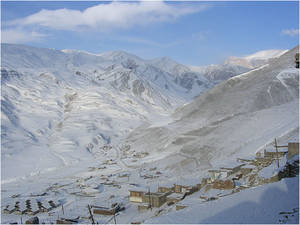Dating the Neanderthals of Mezmaiskaya Cave
Interview with
Diana - Let's now take a trip back several tens of thousands of years to early humans. One of the key debates for people working in Paeleontological archaeology is the overlap between modern humans and Neanderthals who did seem to live side by side for a few millennia. But the length in nature of that co-habitation is still a bit murky. The most recent Neanderthals of the Caucasus were only this year re-dated to confirm just how recently they live there and it wasn't as recent as we once thought. To tell us more, Tom Higham...
length in nature of that co-habitation is still a bit murky. The most recent Neanderthals of the Caucasus were only this year re-dated to confirm just how recently they live there and it wasn't as recent as we once thought. To tell us more, Tom Higham...
Tom - We've been interested in chronology building and precise radiocarbon dating for many years. That's one of our main research interests and traditionally, our lab focused on archaeological dating, so we really specialise in that area. And one of the most challenging parts of radiocarbon is dating old things and that's because radiocarbon is an exponentially decaying isotope and by the time you get back to five or six half lives, more than 30,000 years ago, you start to find that the amount of radiocarbon is very, very low and becomes increasingly difficult to measure.
And not only that, it becomes very difficult to distinguish what is radiocarbon dead, in other words, beyond about 55,000 and within the period of 40,000 to 50,000. The period that we're discussing here is very important for looking at the questions regarding Neanderthal extinctions and they're rather the first modern humans into Western Europe. It's been a real challenge to radiocarbon date this.
In the last 10 years, we've been using newer techniques and this has led to a number of revisions of previous dates which we found to be often very much younger than they in fact should be. So for example, when we radiocarbon date a bone from one of these sites using the ultrafiltration method that we've now begun to adopt, and we compare it with dates for the same archaeological samples, or archaeological samples from the same sites, we often find that the ultrafiltration dates were much older and we would consider them to be more reliable because the challenge is always in radiocarbon dating this material to remove modern carbon contamination. That's the real headache for dating this type of material simply because when went down at 30,000, we then got about 3% of the amount of radiocarbon that we have in the modern period.
Diana - What's the situation that you had that Mezmaiskaya then?
Tom - Mezmaiskaya cave is a very important site in the Caucasus, in the southern Caucasus, of Russia and it's important because it's produced physical remains of Neanderthals. There were two infant burials there and one of them has produced DNA that's been used in a Neanderthal genome project, this is the Leipzig based project which has been working for the last few years on developing the Neanderthal genomic sequence. So it's a very important site. Not only that, but it's produced one of the latest dated Neanderthals in Eurasia, around 29000 BP, before present. So it's one of the most recent dates and it's important because it's been taken to suggest a late survival of Neanderthals there compared with other parts of Eurasia.
 So we were interested in testing whether or not this was true, using the ultrafiltration techniques that I was discussing just before. And when we went back to the site and we took the whole lot of samples from throughout the archaeological sequence, we found, as we have in detailed at many other sites, that those young dates just simply went robust and when we re-dated some of the bones, we found that they were up to 10,000 years earlier than they otherwuse would appear to have been. And this is very important of course because it changes the interpretation of the survival of Neanderthals in that area and the amount of time that they may have overlapped chronologically with modern people.
So we were interested in testing whether or not this was true, using the ultrafiltration techniques that I was discussing just before. And when we went back to the site and we took the whole lot of samples from throughout the archaeological sequence, we found, as we have in detailed at many other sites, that those young dates just simply went robust and when we re-dated some of the bones, we found that they were up to 10,000 years earlier than they otherwuse would appear to have been. And this is very important of course because it changes the interpretation of the survival of Neanderthals in that area and the amount of time that they may have overlapped chronologically with modern people.
Diana - Okay, we'll get to that exciting bit in a minute. So, can you compare ultrafiltration to ordinary methods of carbon dating? What are the differences?
Tom - Yeah, well often what we find is that ultrafiltered collagen dates are much older than dates using other less refined techniques. An ultrafilter is sort of like a molecular sieve. It filters out very small molecular weight components and traps above the filter, larger, long collagen molecules that are less likely to be degraded, altered, and contaminated. And so largely, what we find is older dates using ultrafiltration methods, but not always. In cases where we have well-preserved bones for example, with lots of collagen in from permafrost areas, areas where the bones have been well-preserved and sealed, we don't see these effects. It manifests itself most often in places where the collagen levels are low, the contamination possibilities in the sites are quite high, and that's where we see the greatest differences when we use ultrafilters, compared to when we don't.
Diana - So, why don't more excavations use this technique to re-date their find.
Tom - It's only in the last few years that we published the data that shows this. The technique itself was developed in the late 1980s, but surprisingly, it wasn't widely adopted by radiocarbon labs, and we started using the technique in the early 2000s. It was only when I started collaborating with a colleague of mine from the British Museum who was interested in looking at the British Palaeolithic, the British archaeological sequence, that we began to do some serious in comparing old dates with new dates, and comparing different types of pre-treatment chemistry. And it was then that we discovered these dramatic differences that sometimes occurred. And since then we've extended the work into the European sequences where you find many, many sites that include this period. As I've said, we found that often, the ultrafiltration does have a major effect and it seems to produce results that are not only reproducible but also, produce patterns in the data and seem to be much more reliable. We have independent evidence also that backs up the reliability of these techniques.
Diana - And what does this 10,000 years change in date mean for the human populations at that time?
Tom - Well at the moment, there have been huge debates that have been raging in the paleontological world about what happened when the first modern people entered Europe in terms of Neanderthal populations that were living there. And there are a number of huge questions that arise regarding the mechanism of this dispersal and later extinction. Much of this debate hinges upon the amount of time over which populations were contemporary or not. For example, there are huge questions about the amount of interbreeding, if any, that might have taken place when the first moderns reached Europe and found Neanderthals there. Similarly, how much cultural exchange was there between the two, and this have been really strenuously debated for many, many years - did Neanderthals copy modern humans and did they copy aspects of the technology? Was it the reverse? Did Neanderthals come up with their own version of the upper Palaeolithic revolution? Did they develop new techniques of making stone artefacts and bone tools which were then copied by incoming modern humans? And as I said, it all comes back to the chronologies.
If we have radiocarbon dates such as the one we had from Mezmaiskaya which is 10,000 years younger than we now know that they are then this changes completely the interpretation of the contemporaneity of these two groups of humans. So, when we go back and we re-date these sites and we find that the dates actually don't stand up to scrutiny, you can imagine that what's called for then is a much wider project in which we date many, many sites, once again, to find out the real chronology. But I think that rather than seeing a long contemporaneity, the most likely scenario is that there isn't probably a great deal of overlap between the two populations and for whatever reason, we think that Neanderthal extinction parallelled rather closely the arrival of the first people. That's our hunch looking at it now, but we've got a lot of work still remaining to do and a lot of modelling that needs to take place before we're 100% confident in publishing our data yet. But I think that's probably what we'd expect to see.










Comments
Add a comment